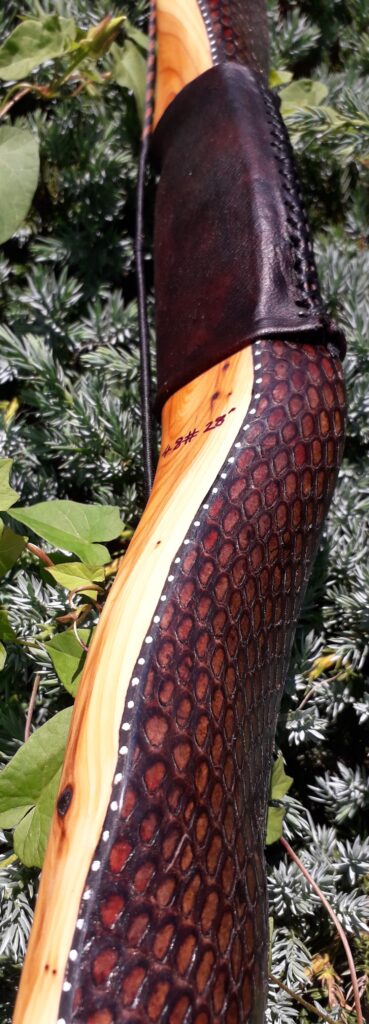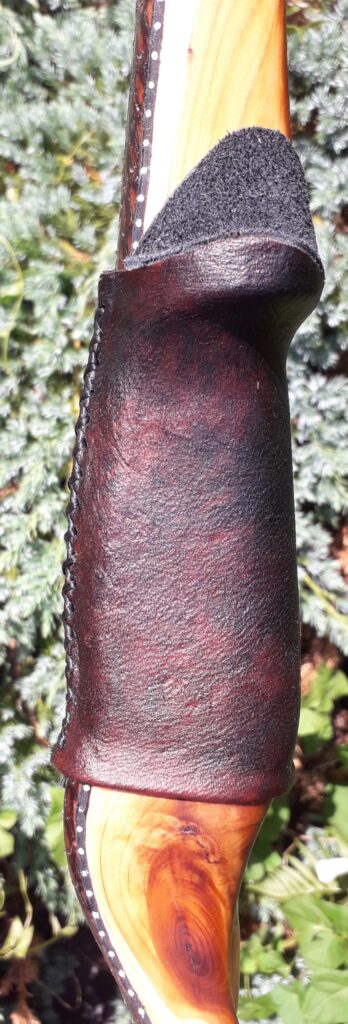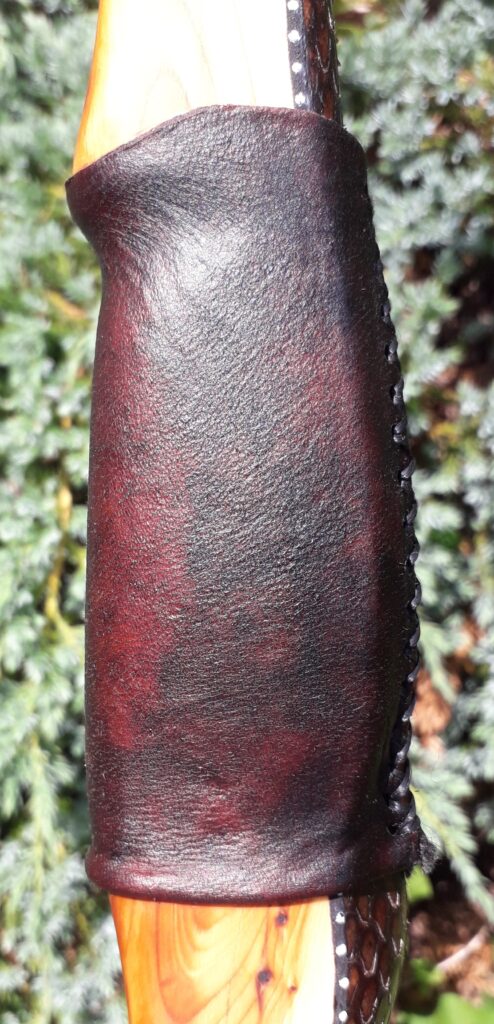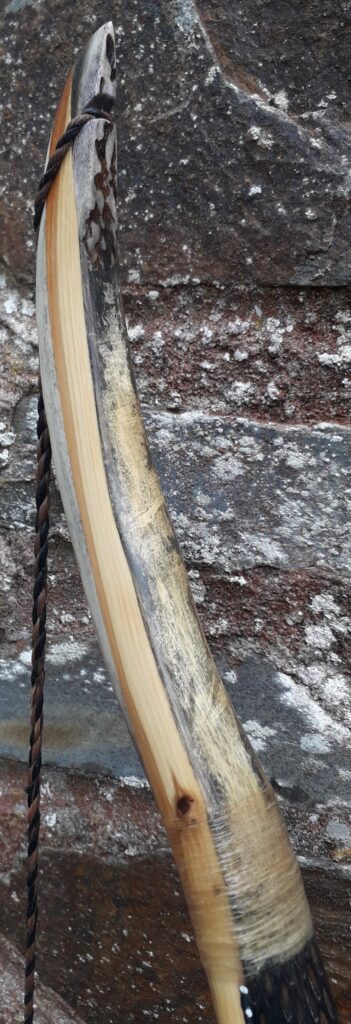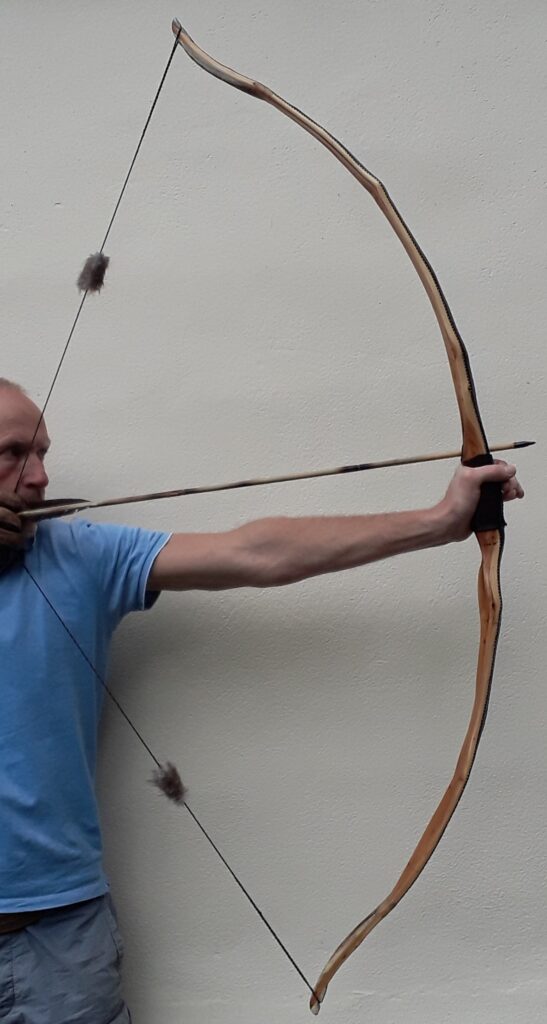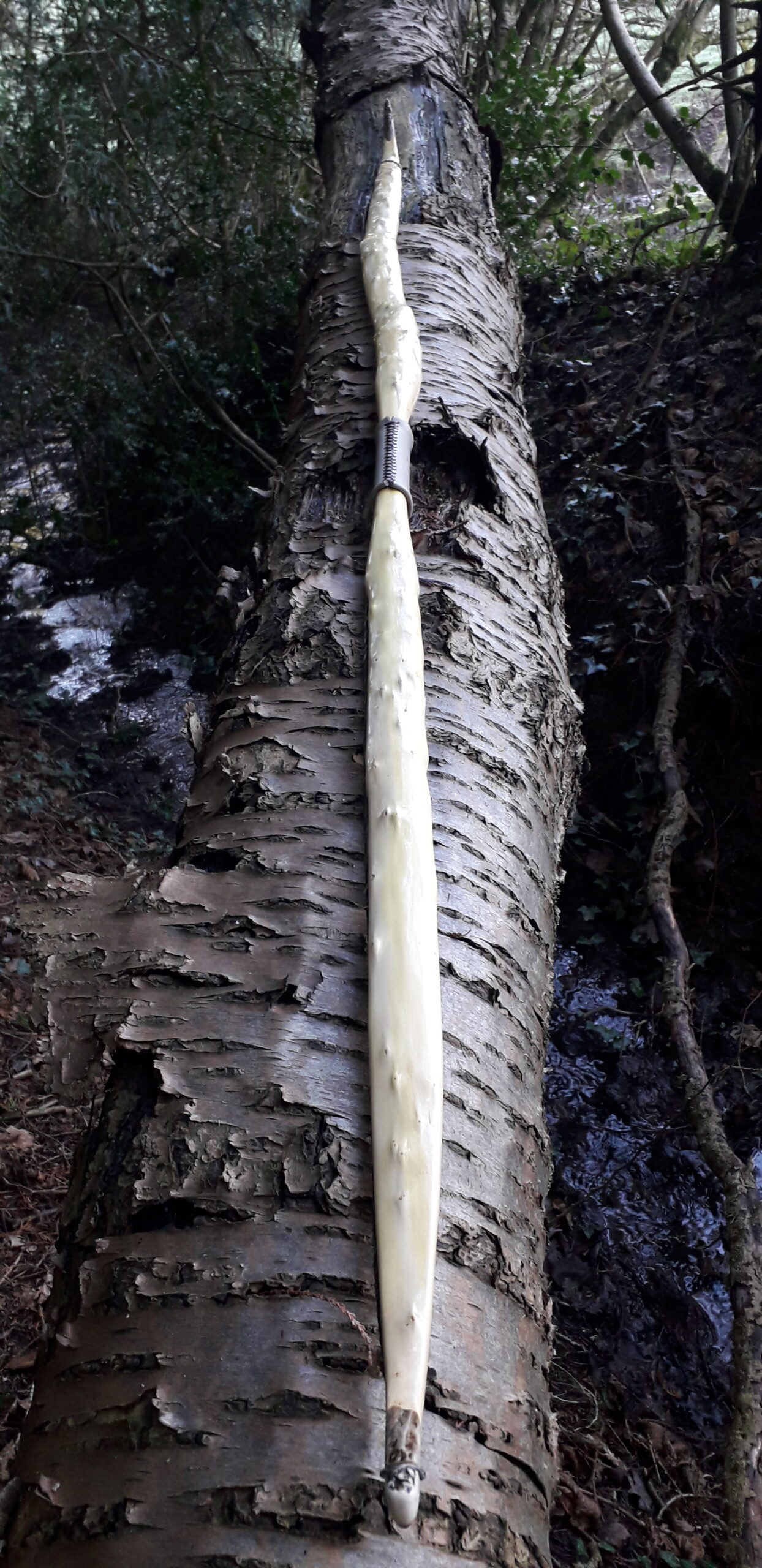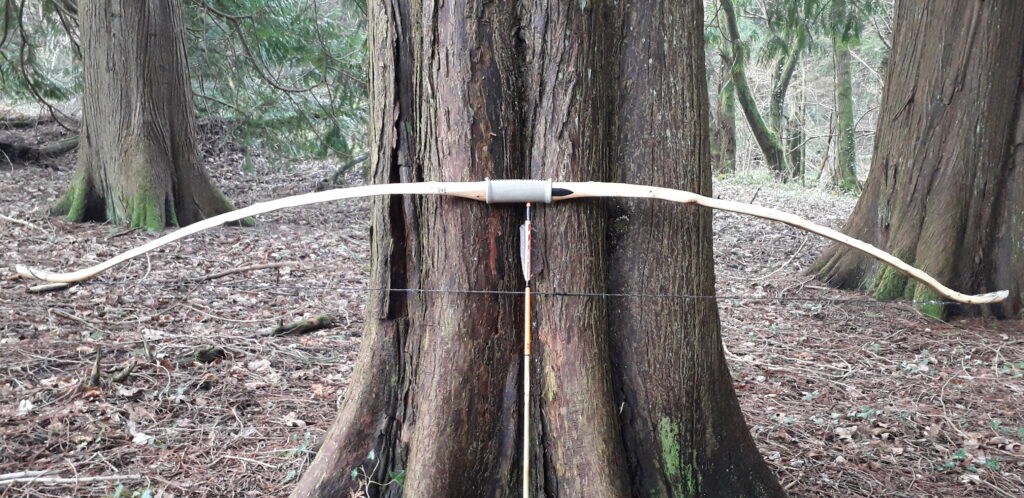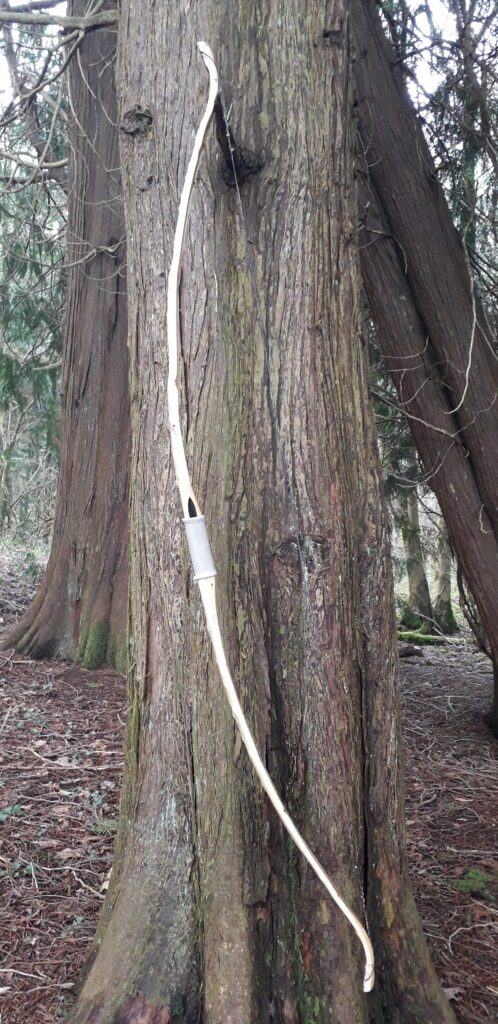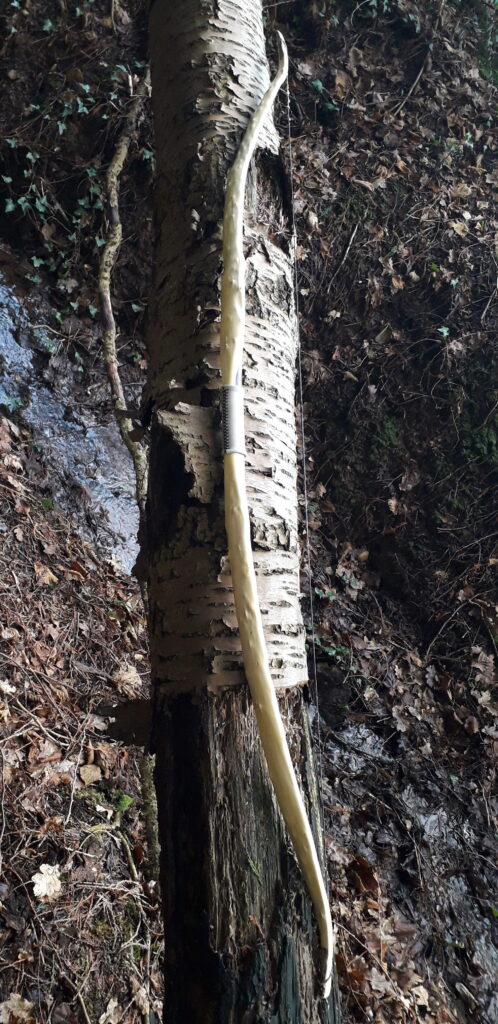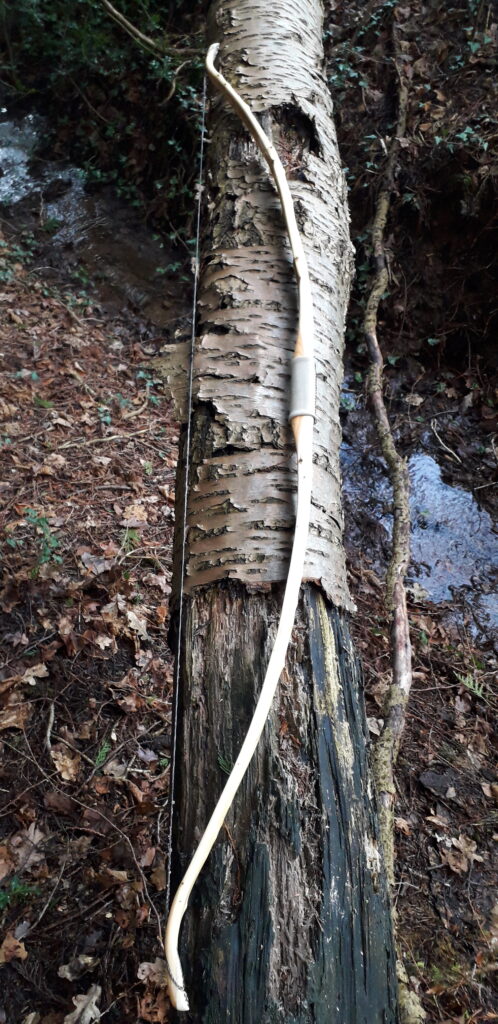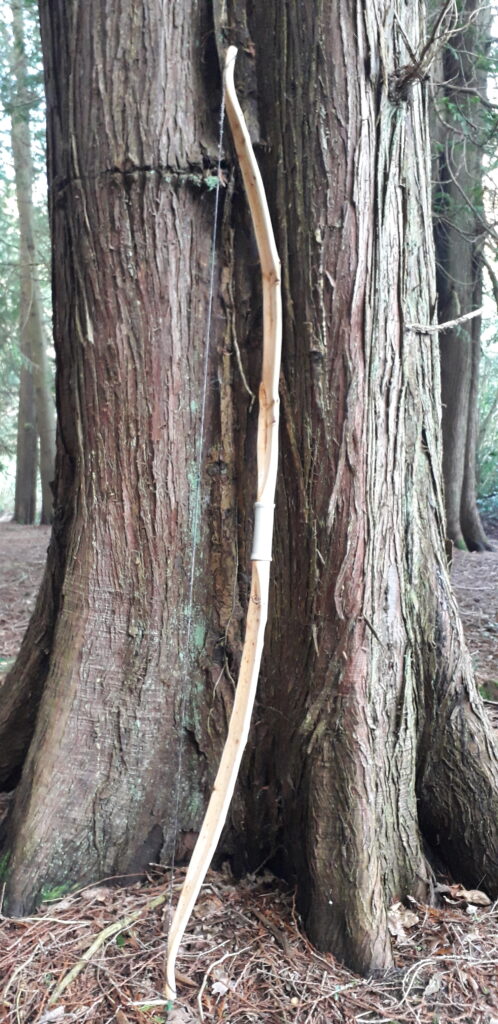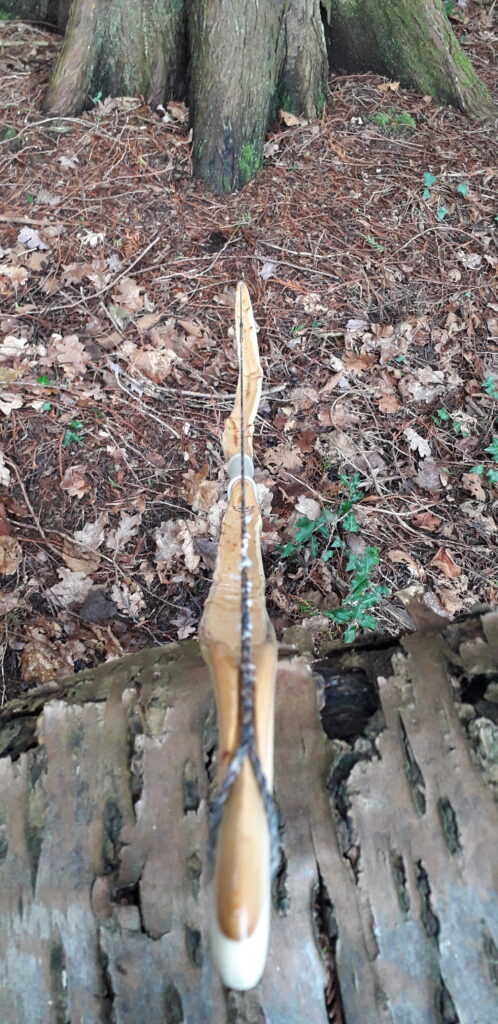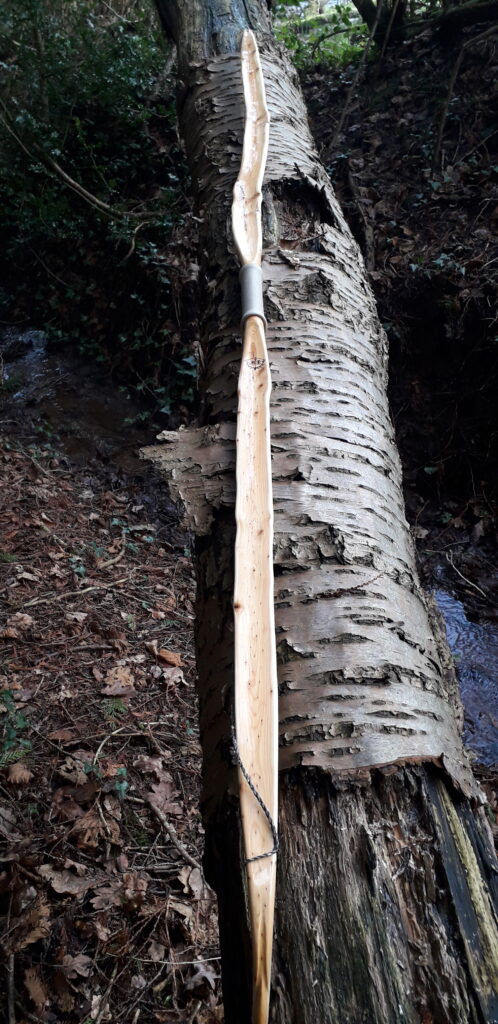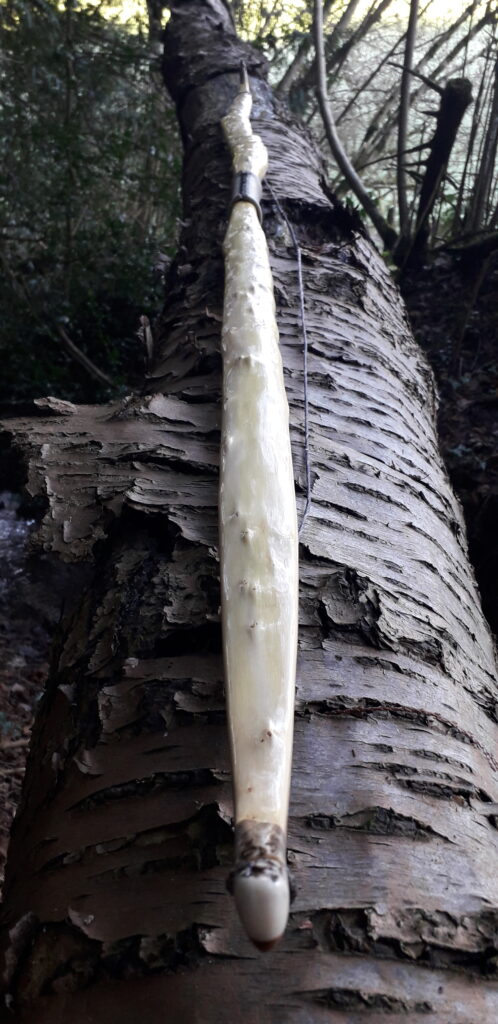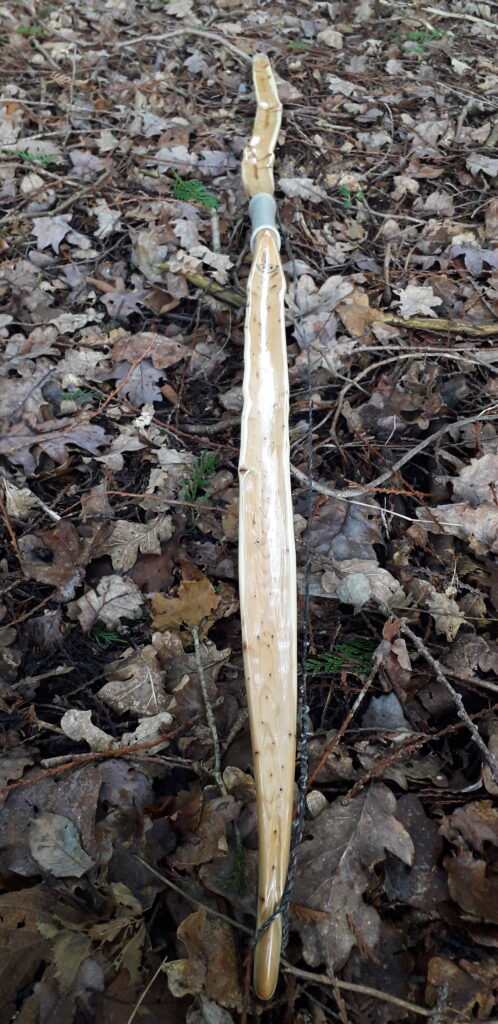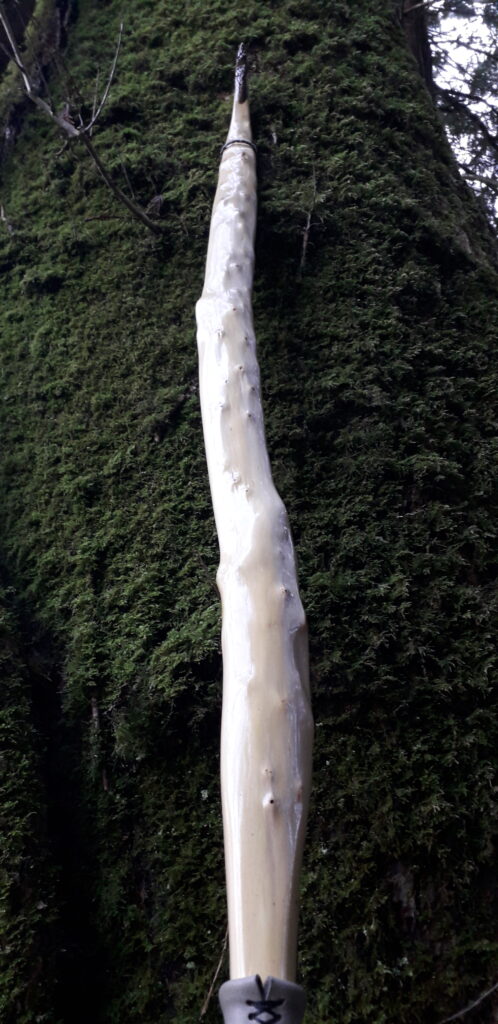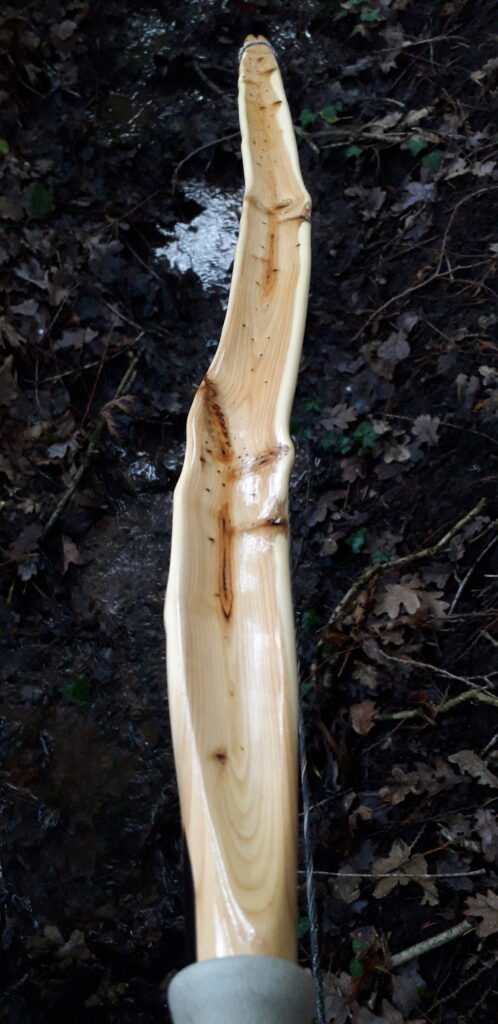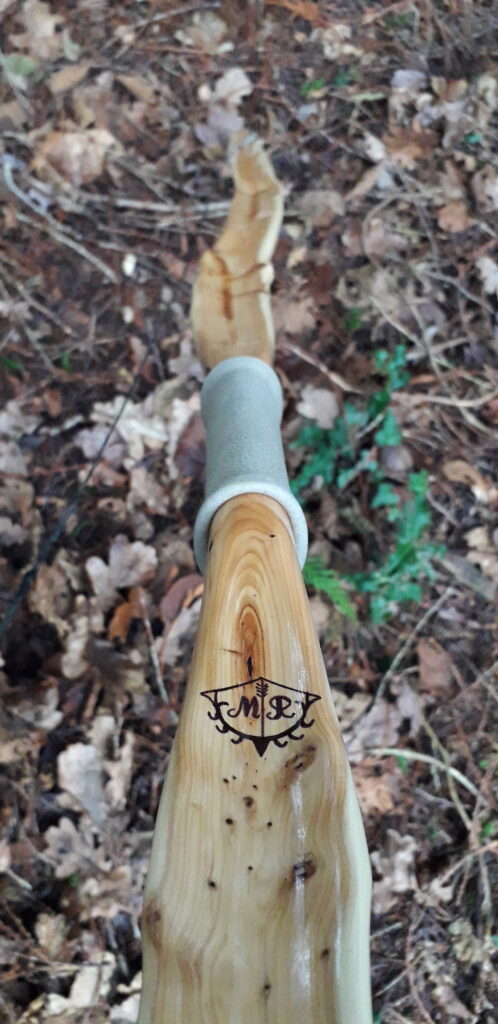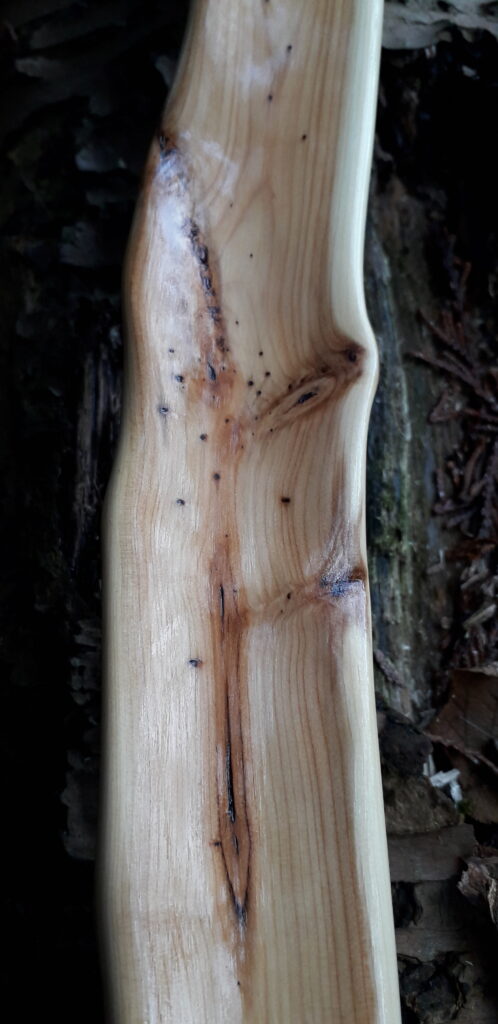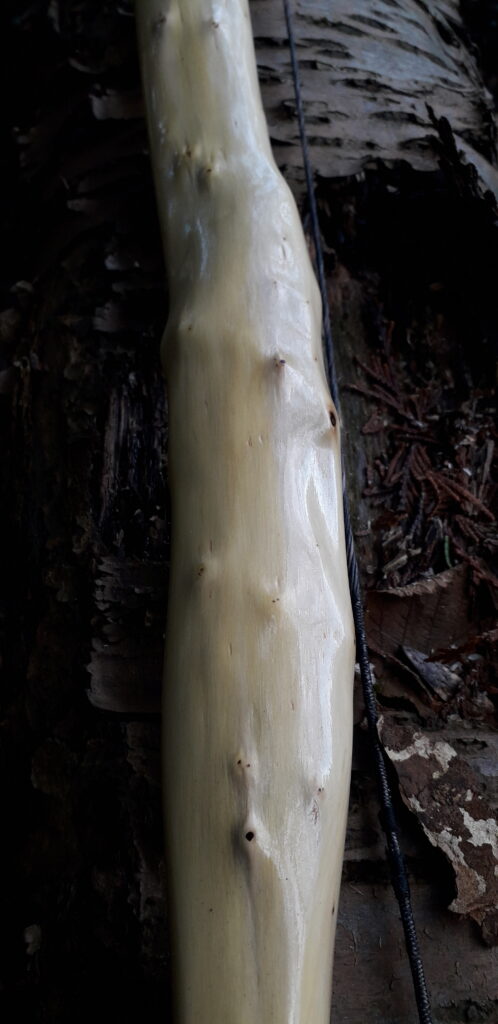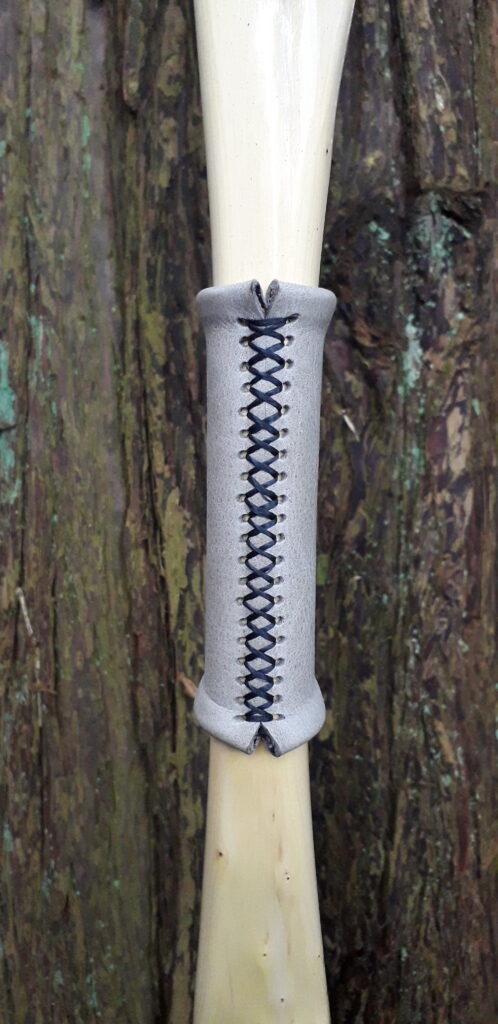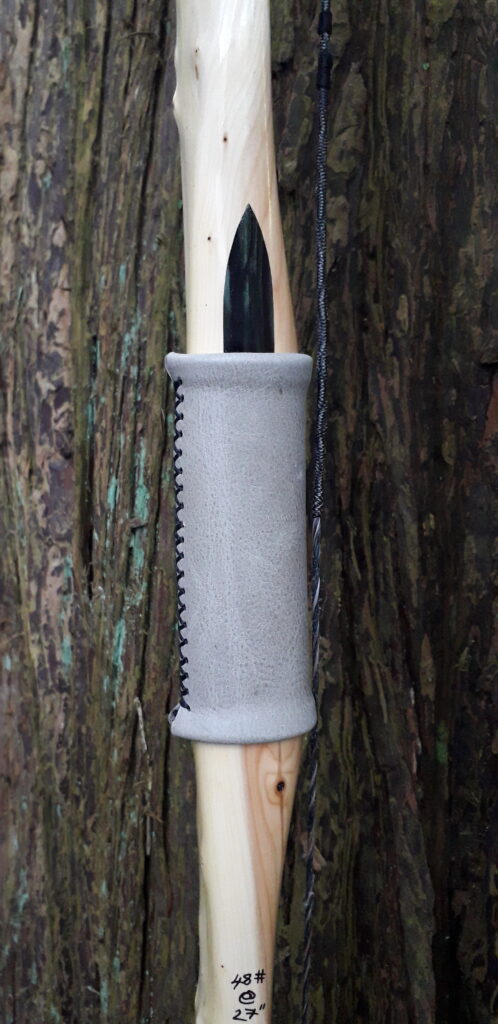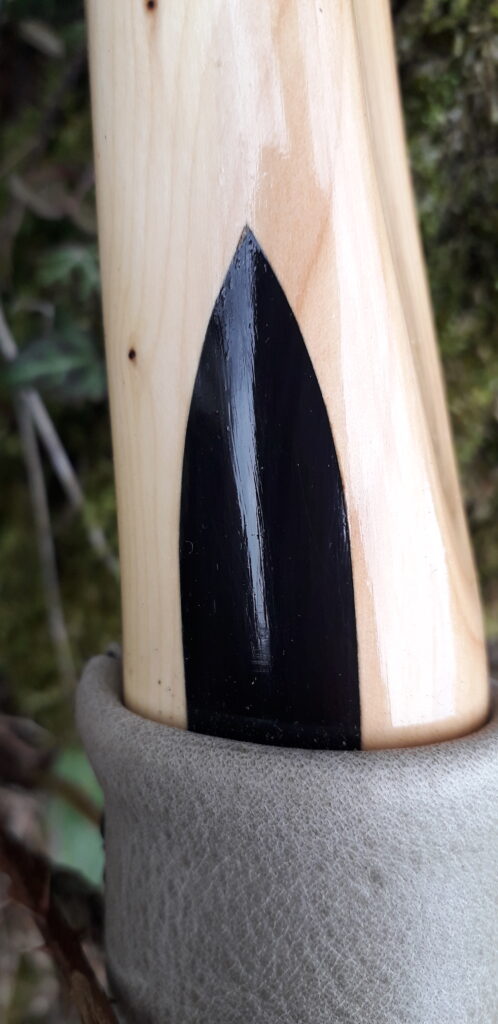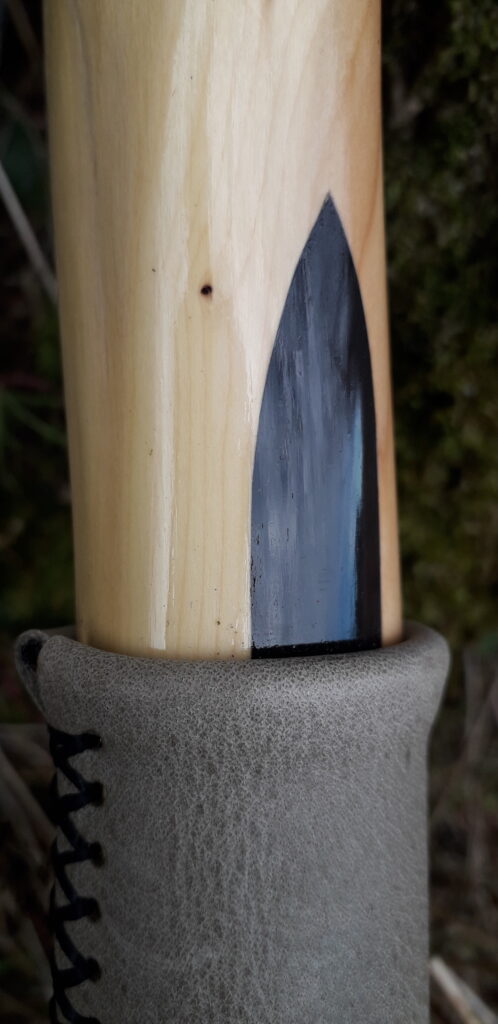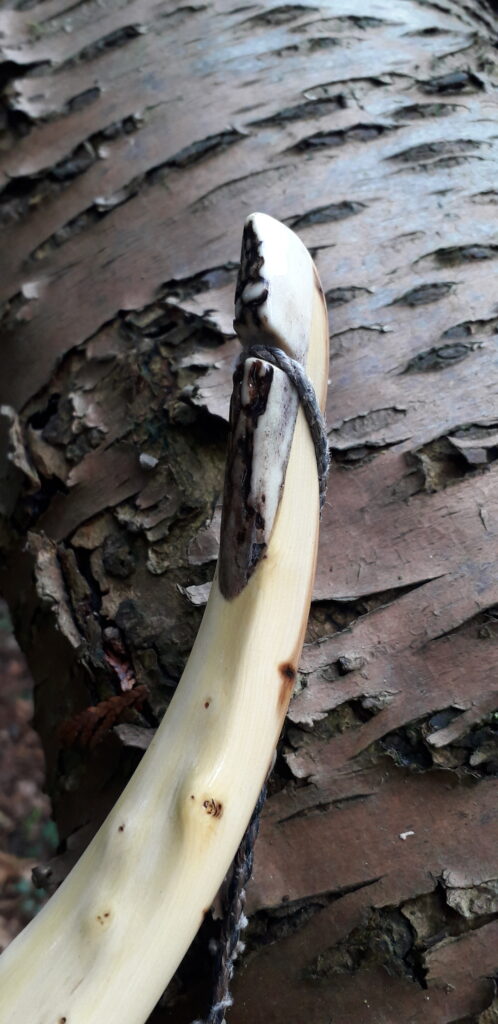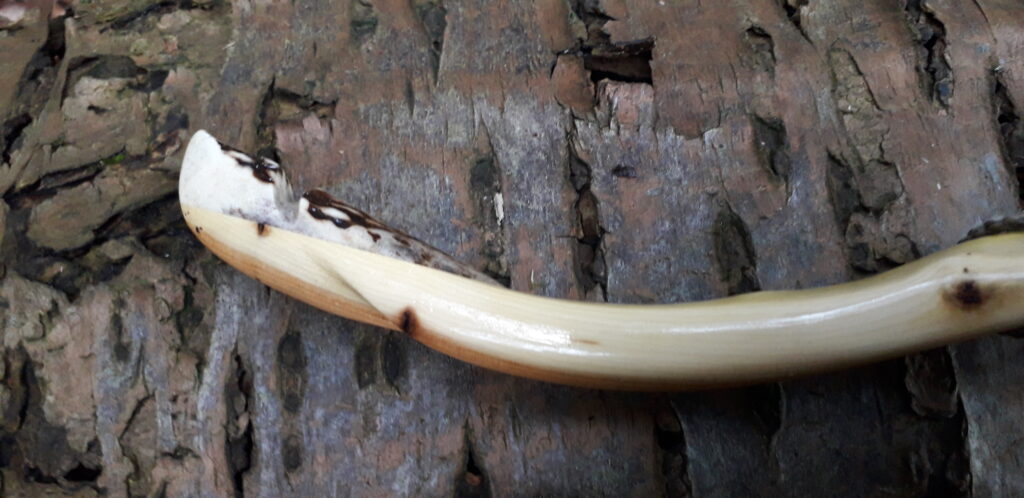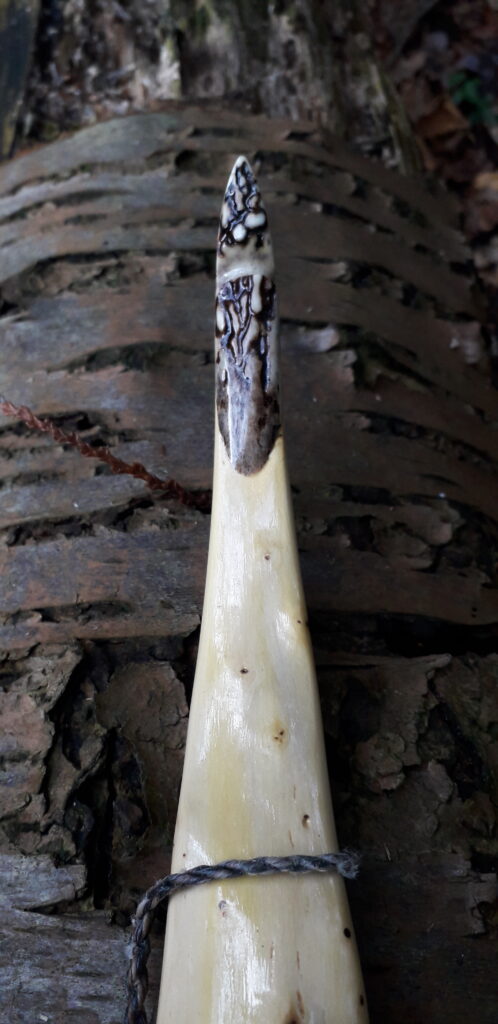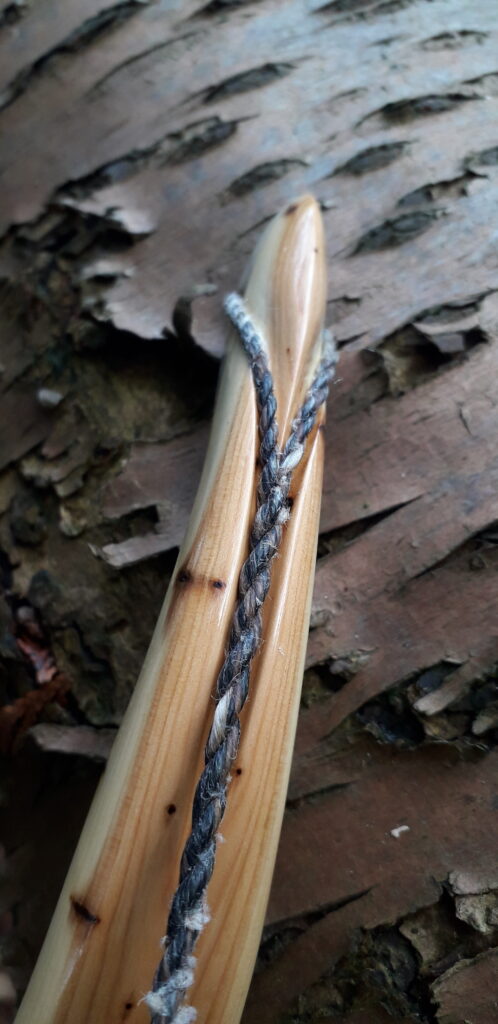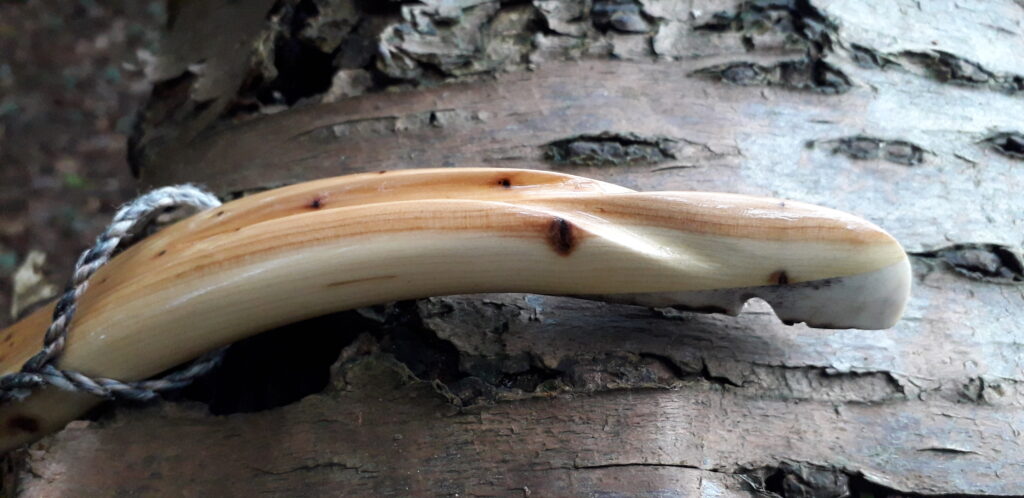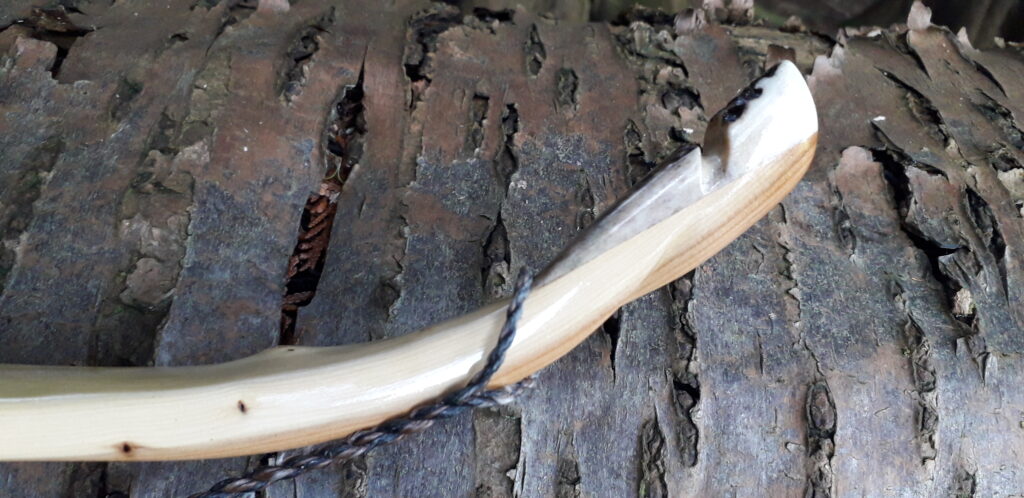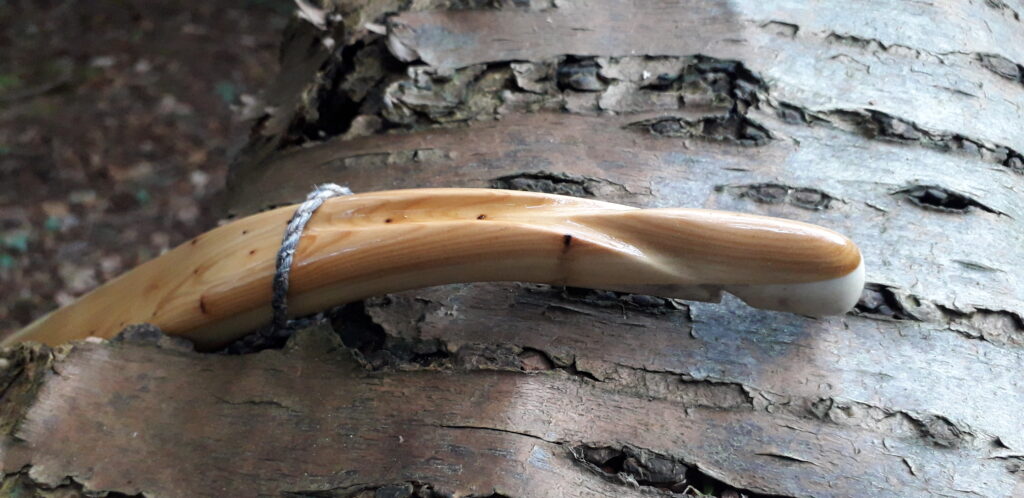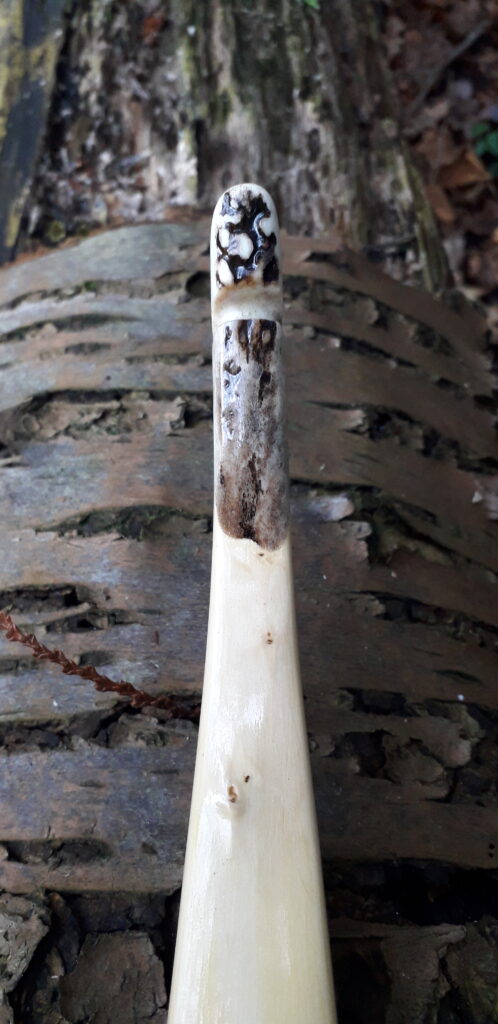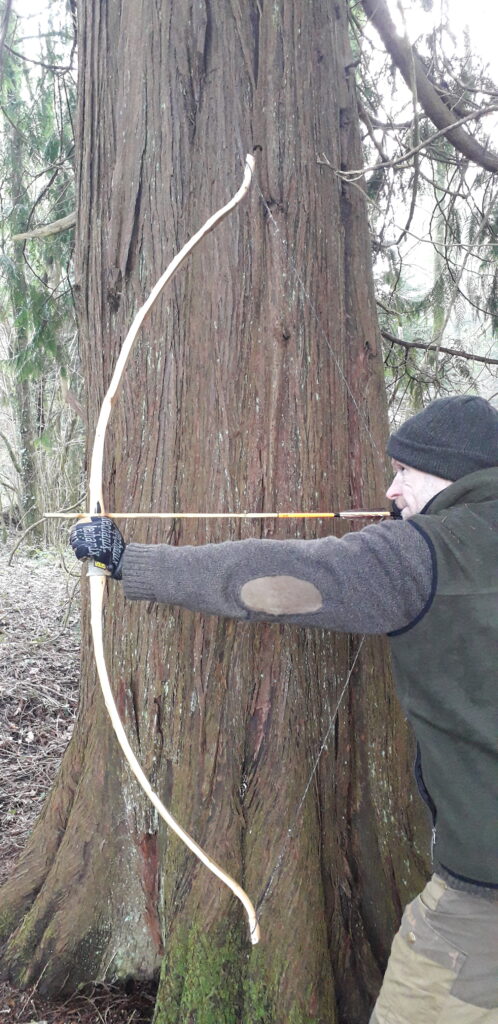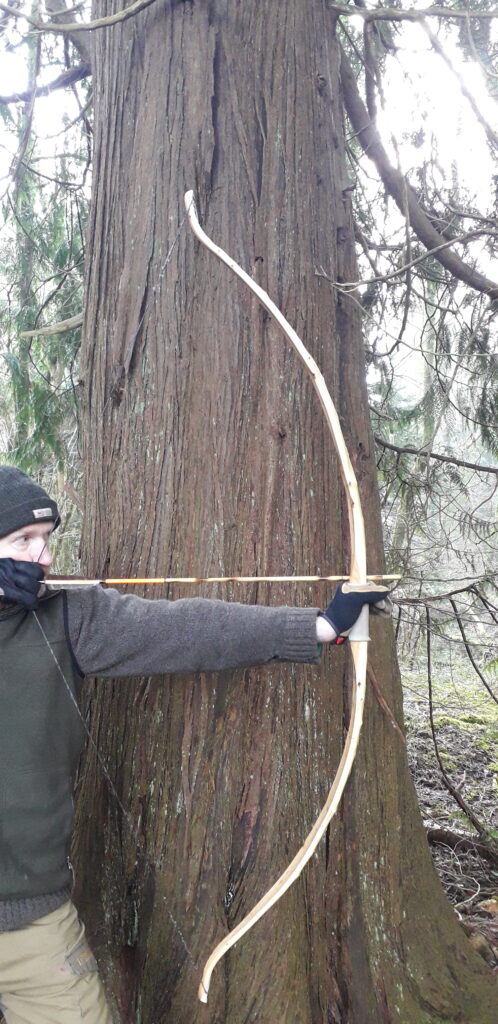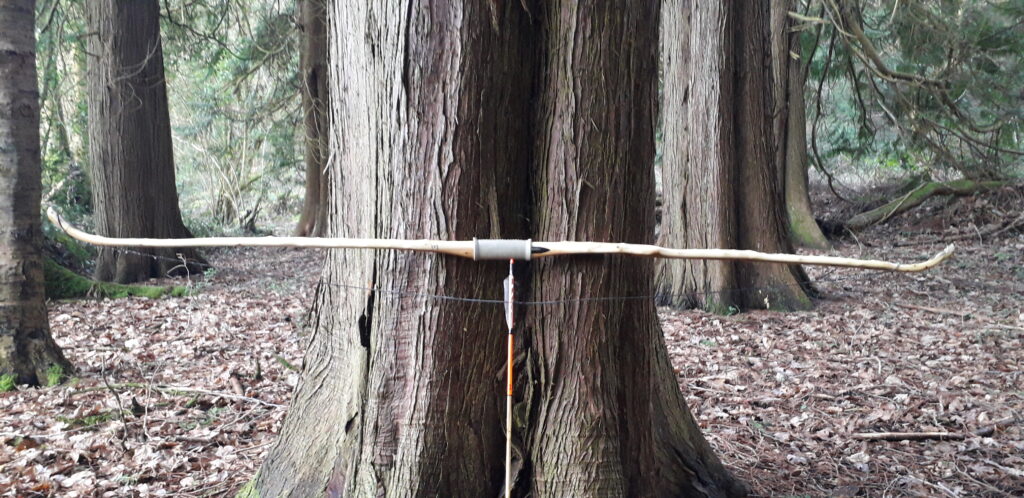A mate of mine gave me this stave ages ago and said ” I bet you cant make a bow out of that!” To be honest, on first inspections I agreed with him!! But on closer examination, in principle, this 4-5″ diameter yew branch had plenty of potential. For a start, the best face (which had been the top of the branch as it grew of the tree) was fairly clean of knots, bar a few wispy bits of epicormic growth. With this face showing promise I inspected the cut ends of this 74″ branch. The sapwood/heartwood ratio looked good with about 8mm of sapwood showing. The heartwood was a beautiful dark orange and densely ringed. The pith was clearly biased towards the face I could use, which was to be expected given that the top of a branch typically has the thinner growth rings, and this was certainly the case with this particular branch.
The thinner end of the branch had a big drying split extending several inches into the usable part of the branch so it was obvious that this section would end up as an offcut. That would leave me with around 65″ of decent stave to work with. The branch was certainly undulating along it’s entire length and very slightly reflexed along what would be both limb sections, however the section which would make for the handle had a significant roll in it due to a massive knot on the belly side. This knot was going to require some thought to deal with. The large roll that this knot had produced was also presenting some deflex in what would be one of the handle fade areas, but only on one side. This would need to be either excepted as character and incorporated into the bow design, or possibly heated out to some extent.
This knot was presenting another problem too as it was causing a significant side bend which would throw the string alignment out of centre by a good couple of inches. The likely hood of this misalignment being removed completely was low since I could see that this large knotted section would only bend through substantial steam heating. To over cook an already cracked knot like this would invariable result in a massive crack right in the lower fade/handle so I was forced to except that the best I could hope for in relation to fixing the string mis-alignment was to end up with a bow with the string slightly favouring the side which it naturally wanted to. This was a shame as I’d sooner the branch was bent the opposite way as the limb which would have to be the lower limb was nice and snakey, and therefore the limb which was carrying the most character. I’d much sooner that this limb had made the top limb since it’s always better to have the most characterful limb as the top limb, or at least in my opinion!
Despite the branch being 4″ wide at the thin end (closer to 5″ at the fat end) the face which was usable was quite crowned. In my mind a bow made from a branch like this one would benefit from having hollowed out limbs. Digging the limbs out would also ensure that all of the pith was removed since the pith was running close to the back of the stave in the thinner end.
So after getting the bark of so i could see exactly what i had to work with, I cut the branch back to 65″. I then began reducing the belly material with the axe. Once an approximate limb orientation and thickness had been established I set about working down the edges to create and approximate face profile. The branch was starting to look something like a roughed out bow now so I set about working out exactly where the handle and fades would sit. My idea was to turn this stick into a 50lb ish, asymmetrical, pyramidal longbow with a four inch handle and 3-4″ fades. I also liked the idea of flicking the tips very slightly, and on a yew HLD this long, the tips could easily be static.
I decided to go for a contoured handle with a shelf. The large knot was going to be located in the bottom of the handle where the fade transition was going to be. This unfortunately put the large roll which was previously mentioned right in the bottom fade too. due to the shape of this roll, it was becoming apparent that I was going to have to except a thicker bottom fade. Had I tried to keep the fade thickness the same for both the top and the bottom, I’d have ended up with a handle which would have been shaped in a way which was uncomfortable to hold. So I decided to accept the thicker lower fade and use it as an opportunity to act as a canvas for the rather beautiful, albeit inconvinient knot.
With everything now roughed out I got the handle over a pan of boiling water and set the timer for 45 mins. Whilst she was steaming away, I said a quiet prayer the the bow gods and asked that they would see that the knot did not split through the handle and fade. My prayers where obviously heard as the thin seasoning check which was there already did not get any worse. So with the handle and fade nice and hot I put the stave into my bending jig and gently eased the string alignment back to centre. After cooling for several hours the clamps came off and further inspection confirmed that the string alignment was now just a tad off centre and favouring the correct side for a righty. Hopefully it would stick!
Next I flicked the tips with the heat gun whilst the limb thickness was still excessive. At least that way, if one of the small pin knots popped during bending I might have some extra material I could remove to take out the cracked pin. I didn’t go mad with the recurve jig so the tips survived the modest amount of flick. At this point I was thinking back to a post I’d seen on PA years ago where a seasoned bowyer had used antler main beam to reinforce and make static recurves on a beautiful osage primitive. I’d put aside a few bits of Red Deer main beam with the intention of trying this strategy for my self some time. So I decided that now was the time to give antler reinforced static tips a go!
After matching the antler pieces to the shape of the recurved tips, I glued and clamped them in situ with TBIII. This would now mean that the tips were set in place so if the tips needed alignment work later on then I would have to apply heat and bend from within the working section of the limbs, fades or the handle. Since the tips actually lined up reasonably well already, I didn’t envisage having to do much tweaking except maybe for some very minor twist. This small amount of twist came out quite easily with some dry heat later on.
Now the tips were set up I proceeded to hollow out both limbs. First with the gouge and then the goose neck scraper I mirrored the various undulations found on the back and projected those same contours onto the belly in reverse. Where there was a hump on the back, the belly would get dug out deep. Where there was a flatter spot on the back, I would shallow out the digging. By aiming for any even 14mm thickness at every spot between the handle fades and the fades of the static tips, it was pretty easy to get a good floor tiller.
Temporary nocks were cut into the tips which, at this point, were still oversized in terms of width. Then onto the tillering tree she went for some first pulls with the long string. The bottom limb looked very stiff so that was dealt with first. Next the inner third of the top limb was let off a touch until the elliptical tiller I was gunning for was achieved. With both limbs bending evenly, albeit with a slightly stronger bottom limb, I got her braced. At this point she was still very heavy so after working down to 50lbs at 22″ I decided to stop and get a rawhide backing on her.
After hide gluing on a couple of nice, thin, strong, home produced red deer rawhide strips, I considered decorating the rawhide with artwork, or maybe a stain. But then I remembered that I had a really beautiful full length cobra rawhide begging to be used somewhere in the workshop. On the cobra skin went along with a pair of red deer antler tip overlays and some deer back strap sinew to secure the antler static tip reinforcements. This sinew wrapping would also double as a means to cover the transition between the end of the cobra skins and the underlying rawhide.
After a week of drying she went back on the tillering tree for the last part of the journey. She was in need of a bit of rebalancing since the backings had moved the tiller a bit but in pretty short time she was back to an nice elliptical 1/8″ positive, pulling around 48# at 26″. I took her our stump shooting for a week to shoot in the last couple of inches as I always do. Final assessment (post shooting in) was that the tips needed just a fraction of twisting in opposite directions to get some better string alignment. Other than that she was holding the positive tiller and after a couple of hundred arrows had settled into 48lb at 28″.
Final touches where a nice thick piece of red stag neck rawhide for a handle covering, and a touch of black stain on the section of exposed rawhide visible at the tip sections. This stain was then wire wool scrubbed to create an aged look. I deliberately left the tips unbacked with the cobra skin as in my experience, snake skin will often end up getting very worn and tatty towards the tip of the upper limb due to the constant rubbing brought about by stringing the bow.
I painted the edges of the snake skin with a thin black boarder line overlayed with white dots to make the contrast between the tan snake skin and the yew sapwood really pop. And the whole bow including the rawhide handle was finished with 6 coats of tung oil applied over a couple of weeks to let it really soak in. I find that this type of satin oil finish really draws out the grain of yew heartwood really well.
I really like how this bow came out even though she is a big heavy girl. I think she’s a real looker with lots of character. And she can sling an arrow too! The obvious advantage of having a bow like this one with string alignment which clearly favours the left side, is that arrow fussiness is not an issue. I shot 40#, 50# and even 60# arrows through this bow and they were all achieving acceptable arrow flight. I was a bit concerned that the weight of the antler reinforcements in the static tips would create a bit of hand shock but by keeping the mass down to a minimum, hand shock is not an issue.
As much as I love the look and performance of this bow, I’ve not got the space for her and would love to see her end up getting shot with the degree of regularity which she desires, so this bow will be made available to buy through my shop. If you would like to become her proud owner then please visit my Esty shop here: Snake Skin Rawhide Backed Primitive Yew Longbow 4828 – Etsy UK
Here are the stats:
Mass: 858 grams with string
Length NTN: 64”
Width: 1 7/8” at widest
Tips: 8” static 7/16” wide
Back: Marginally crowned with undulations. Face profile pyramidal.
Belly Profile: Working limb sections concaved to mirror back, transitioning at the tips to D shapes cross section.
Tiller: Elliptical 1/8” positive.
Draw Weight: 48lbs at 28”











